Mucoromycotina Fine Root Endophyte Fungi Form Nutritional Mutualisms with Vascular Plants
- PMID: 31358684
- PMCID: PMC6776871
- DOI: 10.1104/pp.19.00729
Mucoromycotina Fine Root Endophyte Fungi Form Nutritional Mutualisms with Vascular Plants
Abstract
Fungi and plants have engaged in intimate symbioses that are globally widespread and have driven terrestrial biogeochemical processes since plant terrestrialization >500 million years ago. Recently, hitherto unknown nutritional mutualisms involving ancient lineages of fungi and nonvascular plants have been discovered, although their extent and functional significance in vascular plants remain uncertain. Here, we provide evidence of carbon-for-nitrogen exchange between an early-diverging vascular plant (Lycopodiella inundata) and Mucoromycotina (Endogonales) fine root endophyte fungi. Furthermore, we demonstrate that the same fungal symbionts colonize neighboring nonvascular and flowering plants. These findings fundamentally change our understanding of the physiology, interrelationships, and ecology of underground plant-fungal symbioses in modern terrestrial ecosystems by revealing the nutritional role of Mucoromycotina fungal symbionts in vascular plants.
© 2019 American Society of Plant Biologists. All Rights Reserved.
Figures





References
-
- Brundrett M, Bougher N, Dell B, Grove T, Malajczuk N (1996) Working with Mycorrhizas in Forestry and Agriculture. Monograph, Australian Centre for International Agricultural Research . Pirie Printers, Canberra

